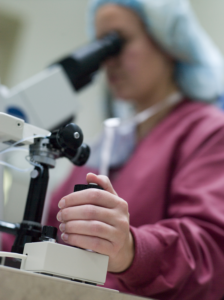ICSI: Tiny Steps, Giant Leaps – Innovations Transforming the Path to Parenthood
When it comes to IVF and assisted reproductive technologies, success often hinges on micromanipulation – the incredibly precise handling of individual eggs and sperm. One of the most game-changing techniques in this world of tiny wonders is Intracytoplasmic Sperm Injection (ICSI). Let’s dive into ICSI, the exciting innovations changing the way it’s performed, and the critical role of reliable distributors in ensuring the availability of the very best equipment.
ICSI: A Quick Refresher
Think of ICSI like playing the world’s most critical game of miniature pool. Instead of a cue stick, an embryologist uses a super-thin needle (way thinner than a human hair!) to pick up a single, carefully chosen sperm and directly inject it into a mature egg. ICSI revolutionized the treatment of male factor infertility because even if a man has very few or low-motility sperm, there’s still a chance for fertilization.
The Tools of the Trade
To pull off this microscopic miracle, you need some specialized gear:
- Inverted Microscope: Think of this as the embryologist’s high-powered magnifying glass. It gives a crystal-clear view of the egg and sperm. For ICSI, high-quality optics are vital.
- Micromanipulators: Super fancy robotic arms that allow for precise movements of the ICSI needles. Their control and stability are essential for successful procedures.
- ICSI Needles: These tiny glass pipettes let the embryologist hold the egg in place and pick up and inject the sperm. Manufacturing them requires specialized expertise.
- Microinjector: Controls the pressure needed to handle the sperm and the egg without damaging them.
These are the basics, but just like any tech-driven field, ICSI equipment keeps getting upgrades!
Innovation Spotlight: Where ICSI Gets Even Cooler
Let’s look at some of the most exciting ways ICSI is leveling up in recent years:
-
“Seeing” the Invisible: Sperm Selection
- It’s not just about whether a sperm can swim. Its inner health matters too! New imaging techniques attached to specialized microscopes (IMSI) let embryologists spot potential damage inside the sperm that a regular microscope can’t detect. It’s like having X-ray vision for sperm, leading to better choices and potentially higher success rates.
-
AI, the Embryologist’s Helper
- Artificial intelligence is making its way into the IVF lab! AI-powered software can analyze sperm videos, flagging the ones that move and look the healthiest. Other AI systems assess egg quality. These tools don’t replace the embryologist but offer a ‘second opinion,’ saving time and boosting precision.
-
Automation: Robot Hands Lend a Pipette
- While the delicate touch of an embryologist is irreplaceable, some ICSI steps can be automated. Robotic systems can do repetitive tasks, freeing up embryologists for the trickier work and reducing potential human error.
-
Keeping Things Chill: Cryopreservation
- Not every egg and sperm gets used at once. Freezing (cryopreservation) is like hitting ‘pause’ on fertility. Advancements in ‘vitrification’ (super-fast freezing) mean eggs and sperm have better survival rates post-thaw, expanding options for patients. This requires specialized storage and transport solutions to maintain temperatures.
Beyond Technology: Innovations in Care
It’s not just about fancier devices; how ICSI is delivered is changing too:
- Gentle Stimulation: IVF involves hormone medications to stimulate egg production. New protocols use lower doses for some patients, leading to fewer side effects and a more comfortable experience.
- Patient Empowerment: More clinics are focusing on detailed explanations, transparent success rates, and even video access where patients can watch their own ICSI procedure happening in real-time.
The Human Factor: ICSI’s Biggest Strength
Even with the coolest innovations, ICSI remains a testament to the skill of clinical embryologists. These are the scientists who turn microscopic possibilities into real-life miracles. As technology improves, their expertise becomes even more powerful, offering hope to couples facing infertility.
The Distributor’s Mission: When Innovation Meets Availability
All those incredible innovations mean absolutely nothing if clinics can’t access these advanced devices reliably and efficiently. That’s where specialized medical device distributors play their crucial part. The right distributor can:
- Stay Ahead of the Curve: They keep up-to-date with the latest ICSI equipment releases and have established relationships with manufacturers.
- Logistics Expertise: They ensure proper transport, respecting temperature-control needs and maintaining the integrity of delicate devices.
- Training and Support: They offer clinics and staff training on new equipment and techniques.
- Local Knowledge: They understand the regulatory landscape for each specific region and ensure paperwork is in order.
FinDBest IVF: Your Bridge to the Best in ICSI Distribution
Finding the right distributor who truly ‘gets’ the unique needs of ICSI is no easy feat. FinDBest IVF tackles this challenge head-on. Our platform is designed to connect IVF/ART device manufacturers with distributors who:
- Specialize in ICSI Equipment: Find distributors with a proven track record of handling IMSI microscopes, micromanipulators, and the latest cryopreservation technologies.
- Demonstrate Reliability: Access distributor info and evaluate their track records for on-time delivery and device integrity.
- Go the Extra Mile: Identify distributors offering training resources and technical support to clinics for seamless device integration.
Let FinDBest IVF shorten your path to the ideal distribution partners. By ensuring your innovations reach clinics with the quality they deserve, you empower more hopeful parents-to-be around the globe.






